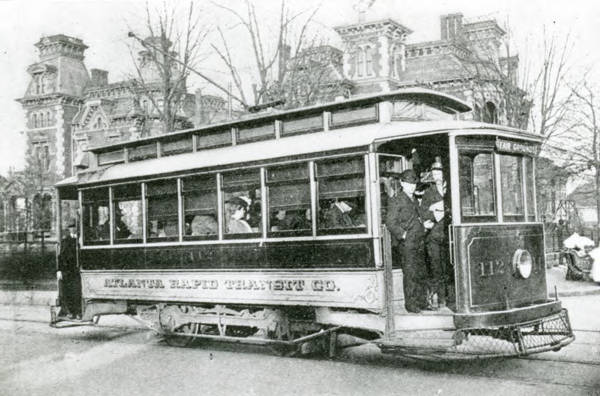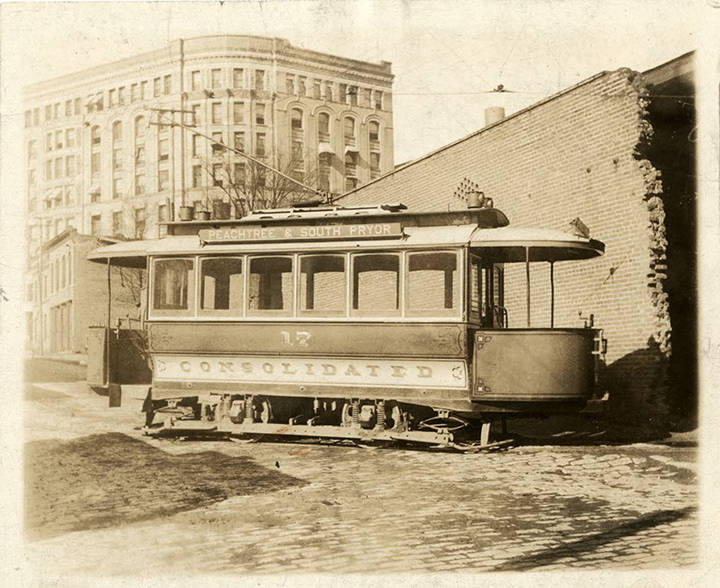Written by Joshua Winston, PhD Candidate at Emory University
From the mule-drawn cars of the 1870’s, to the last rail-based ride in 1949, Atlanta’s streetcar history can be understood as a story of technological innovation, competing business interests, and the urban development of the city’s most iconic neighborhoods. Atlanta’s early streetcars were slow and crowded affairs, dependent on the mules or horses that often drew them across the city. But these primitive cars were eventually replaced with steam powered and electric vehicles that increased accessibility and interest in the burgeoning neighborhoods they traveled to, like Inman Park, Little 5 points and Buckhead. Beyond these intown neighborhoods, the streetcar expanded its reach to neighboring municipalities such as Marietta, Decatur and Stone Mountain in the early 20th century.
For 78 years, the streetcar served a vital role in Atlanta’s transportation network, fostering important connections between the city’s neighborhoods and the people living in them. However, by the 1930’s, the streetcar faced steep competition from the rising popularity of automobiles and increasing operating costs, making its operation less and less profitable for the companies who ran them.

View of a standard single truck street car from the Atlanta Rapid Transit Company, on Peachtree Street between North Avenue and Forrest Avenue.
Atlanta’s once vast streetcar system began as a variety of competing street car company’s operating lines centered in and around downtown. In 1871, the Atlanta Street Railway Company opened the first streetcar line, a mule-drawn route that traveled west from downtown and terminated near present day Spelman college. By 1881, the Atlanta Street Railway company had expanded its tracks north along Peachtree Street, south, down Washington and Mcdonough street, northwest along Marietta street and east along Decatur street towards Oakland Cemetery. The company now operated six streetcar lines covering 11 miles across Atlanta and its suburbs.
As in many public spaces during this time, the streetcar was often a segregated experience but segregation was not uniformly enforced. During the Reconstruction Era of the 1870’s and 80’s, denial of service to African American passengers was prohibited but segregation was left up to the choice of the streetcar companies.
Having to provide a separate streetcar for African Americans proved to be costly and impractical, as mules could only draw one carriage at a time. But with the invention of steam power, a separate car for African Americans could be maintained at little extra cost. This was the solution of the Metropolitan Street Railway Company which provided a yellow-painted car for whites and a red-painted car for African American passengers. Other companies often required that black passengers ride in the back of streetcars.
Following the formal establishment of Jim Crow laws in 1891 in the state of Georgia, streetcars became legally segregated and the Supreme Court’s 1896 ruling in Plessy V. Ferguson led to an even stricter enforcement of this legal segregation. Many African Americans in Atlanta, Augusta, and Savannah, engaged in organized boycotts, causing significant financial damage to the streetcar companies, and resulted in the temporary suspension of streetcar segregation in the 1890’s.
In 1900, the Atlanta City Council passed an ordinance reinforcing the 1891 segregation law that demanded separate street cars for blacks and whites. Despite this ordinance, both of Atlanta’s major streetcar companies, the Atlanta Railway and Power Company and the Atlanta Rapid Transit Company ignored the ordinance and continued to require African Americans to sit in the rear of the car.
Threats and actual instances of widespread racial violence eventually undermined African Americans’ organized boycotts of the streetcar. Specifically, the 1906 race massacre had an outstanding effect on resistance to segregation and Jim Crow, and protest became a largely personal decision with many African Americans still choosing to walk rather than ride the streetcar.
When the streetcars were electrified in the late 1880’s and early 90’s many of the routes running through black neighborhoods remained drawn by mules.
On August 22, 1889, The Atlanta and Edgewood Street Railroad Company opened the first electric streetcar line along the recently completed Edgewood Avenue corridor. This route was established by the prominent Atlanta businessman Joel Hurt to provide transportation to his newly developed residential suburb Inman Park. This route operated on a regular 30-minute round trip schedule from downtown to Inman Park and Atlantans quickly began riding it as a leisurely sightseeing activity.
The second electric street car route was built by The Fulton County Street Railroad Company in December 1889. Like Hurt’s streetcar route, this one was initially developed to attract real-estate development to what are now Old Fourth Ward, Poncey-Highlands and Virginia Highlands Neighborhoods. This route also ran service through the heavily forested, northeastern section of the city. Following the success of the first few electric streetcar lines, many other companies began building electrified routes, setting the stage for a fiercely competitive market in the city. Beyond Atlanta, electrification also swept through the rest of the county with 86 miles of electrified rail track in 1888 expanding to over 22,000 miles of electric track by the turn of the century.
Electrification brought increased competition to the streetcar market but many companies were not able to keep up with the rapid technological change and its associated costs. Atlanta businessman Joel Hurt saw this as an opportunity to consolidate many of the streetcar companies who could no longer afford to compete. Under the name Atlanta Consolidated Street Railway Company, Hurt merged the Atlanta and Edgewood Street Railroad Company, Atlanta Street Railway Company, the Fulton County Street Railroad Company, the Gate City Railroad Company, and the West End and Atlanta Street Railroad Company, and a few others.
Throughout the 1890’s Hurt controlled the largest streetcar company in Atlanta and spent the company’s first few years upgrading the older lines to electricity, eliminating redundant routes or extending new ones to new areas.

View of the “Consolidated” streetcar, number 17, marked “Peachtree & South Pryor,” one of the first electric streetcars used in Atlanta, Georgia.
Hurt’s monopolistic control of Atlanta’s Street car system was eventually challenged and ultimately toppled by Henry M. Atkinson, who wrestled control of the streetcar from Hurt in a series of competitive business ventures that undercut the profitability of Hurt’s own Atlanta Consolidated Railway. This battle began over a potential merger of the Hurt’s Atlanta Consolidated Railway and the Atlanta Railway and Atlanta Electric Railway companies.
The business rivalry between Hurt and Atkinson, nicknamed, “The Second Battle of Atlanta” resulted in the consolidation of the Atlanta Streetcar system. Atkinson purchased controlling shares in Collins Park and Bel Railroad and applied to the city for a franchise to develop competing lines that paralleled Atlanta Consolidated railways most profitable routes. Throughout the spring and summer of 1899, Hurt retaliated with court injunctions and Atkinson publicly accused Hurt of engaging in monopolistic business practices. Atkinson was eventually granted the franchises, and by 1901 had installed about 33 miles of track right next to Hurt’s own streetcar routes, undercutting his business by charging about three cents a ride.
With his streetcar operations severely undercut, Hurt exited the business by selling his controlling stock in the Atlanta Railway and Power Company in 1901. In February 1902, the City of Atlanta approved the merger of all street railroad, electric light, and steam power utilities under the Georgia Railway and Electric company and Henry Atkinson was appointed chairman of the board.
By 1913, Georgia Railway and Electric had doubled the number of street cars in operation with new lines stretching north to Buckhead, south to the city of Hapeville, and out to Marietta. As the streetcar began to reach the outer edges of the city, the company set their sights on outlying suburbs and towns. Track mileage grew from 138 miles to 200 miles by 1914, and service was extended to nearby Chamblee, College Park, and Stone Mountain.
The rapid development of the streetcar was paralleled and eventually surpassed by the rise of the automobile in the early 20th century. Widespread adoption of cars and buses posed a meaningful threat to the streetcar’s success, a threat that was compounded by rising operation and maintenance costs. Additionally, the streetcar faced more competition from unlicensed taxi cab operators known as “jitneys” who began operating in Atlanta, offering faster and more private options for transportation.
The streetcar was also undermined by the introduction of “trackless trolley” coaches, which were buses with rubber tires, powered by the overhead electric wires that also powered the streetcar. These trackless trolley coaches were originally introduced to lower operational costs, and eventually became the more financially viable option for public transit. On June 27th 1937, the East Point-College Park-Hapeville Line was converted to “trackless trolley,” signaling the beginning of the end of the streetcar.
In 1900, Georgia had 80 motor vehicles registered. By 1910, that number had increased to 4,490 cars. This rapid increase in automobile ownership continued well into the 20’s, 30’s and 40’s. And mass adoption of automobiles, along with the deployment of gas powered buses, continued to erode streetcar ridership throughout the middle of the century.
The streetcar survived just beyond World War II by about three years, its life temporarily extended by rubber shortages caused by the war. However, in December 1943, Mayor William Hartsfield called for Georgia Power to replace all of its existing streetcar tracks with bus service by 1947. On April 10th 1949, the last street car expedition took place along the Riverline route. The next year, Georgia Power sold all of its Atlanta Transit business to the Atlanta Transit Company for 4.2 million, marking the end of 78 years of streetcar service.